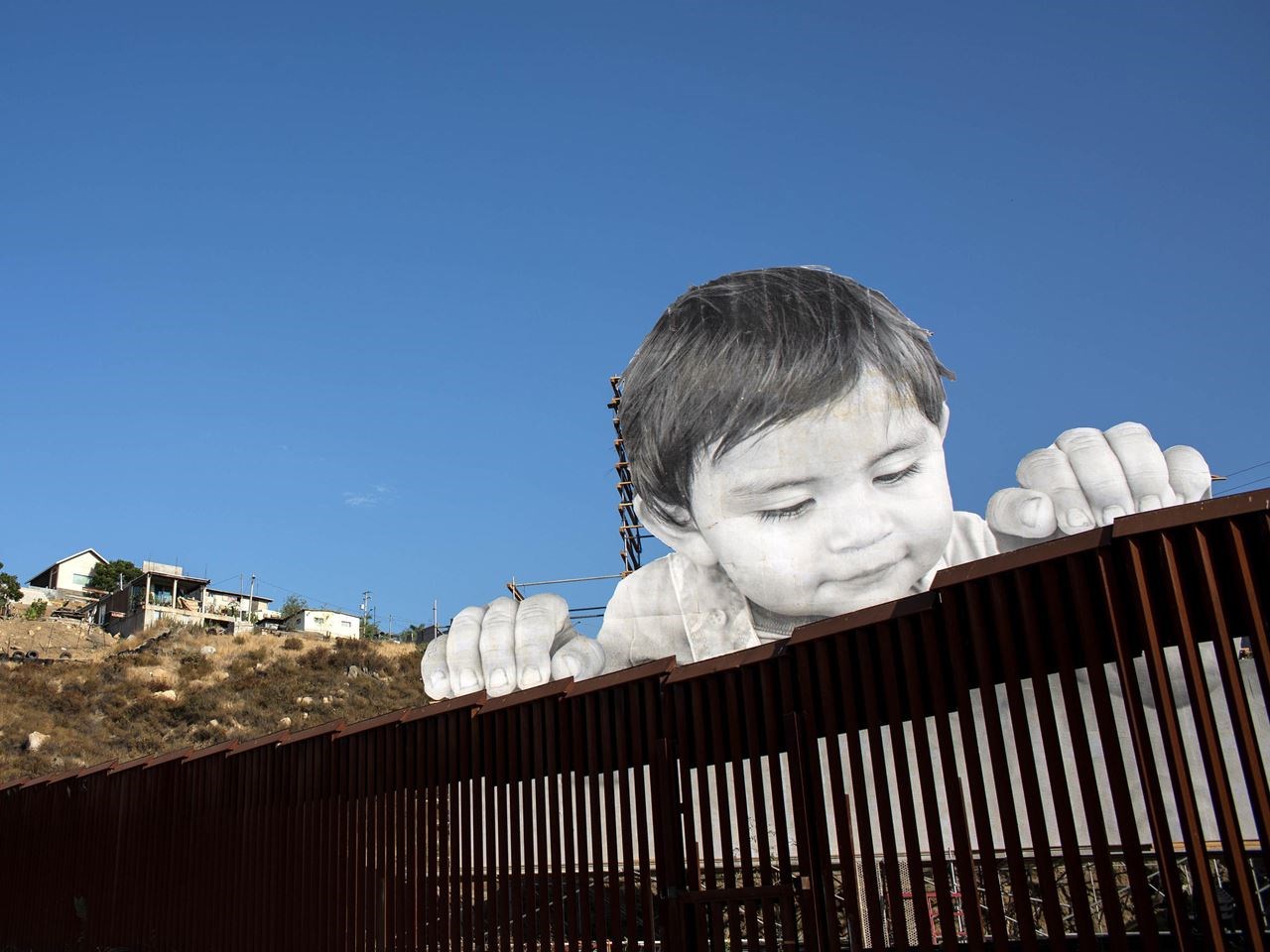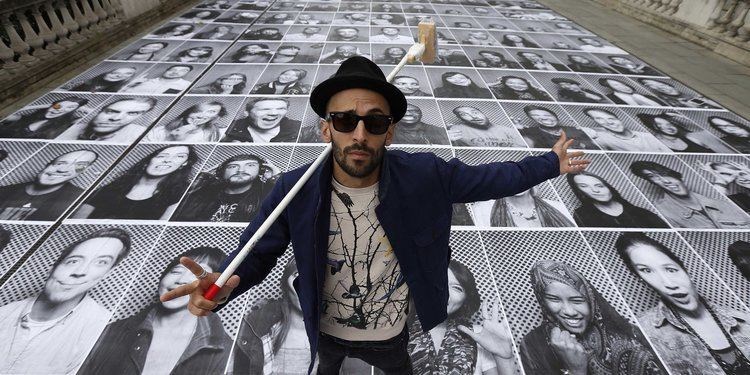 A photo of JR's Mexican border project, called "Kikito."https://www.tpr.org/post/boy-peers-curiously-over-border-wall-his-artist-asks-what-he-thinking
A photo of JR's Mexican border project, called "Kikito."https://www.tpr.org/post/boy-peers-curiously-over-border-wall-his-artist-asks-what-he-thinking
Along the border that separates Mexico from America, the figure of a large child looms above the crude wooden wall that stands between where one place ends and another place begins. The cutout of a child, pictured as small and innocent, is nothing but an imminent reminder of another culture put in place by the modern artist and activist JR, or Jean René. Born in Paris, France, JR was a graffiti artist who turned to combining photography with large-scale art put up anonymously on buildings, trains, and bridges to shed light on lesser-seen communities and cultures. (“JR”). He began gaining recognition after releasing his projects, such as the "Women Are Heroes," project, which displayed women experiencing oppression, violence, and poverty (“JR” Gale Biography in Context). In present time, he often travels to more dangerous places to start new projects and befriend new communities, saying, "I feel like I’m still on that same subway train that was taking me to Paris, and I always want to go further—to the next country, the next country, the next country. And that’s still what I’m doing today" (Benson). Hopping from one country to the next, JR is one of the most influential artists of today, and one that is both fearless and selfless.
 A photo of JR during his project, "Inside Out."https://www.businessinsider.com/works-of-art-by-mysterious-french-artist-jr-2015-7 (REUTERS/Suzanne Plunkett )JR uses his art to change points of view and let people see others beliefs in a new light. He expresses his opinion on the purpose of his art during an interview: “‘The streets have always been a place where people can write their political message. Art is definitely part of the process for people to express their vision and in some countries it’s sometimes the only way that some messages can be passed on’” (“JR” The Talks). JR conveys that an overarching idea of street art is to spread ideologies and give a new platform to political messages. He acts as a translator in the form of art for people whose voices aren’t heard in places where oppressed crowds live, and gives the minorities a chance to make a statement, whether it be against the government or a general idea. An interviewer remarks on JR’s work in an article: “His immersive, interactive global installations reach far beyond the typical gallery-goer, compelling people around the world not only to engage and connect but also to see things from a new angle” (Benson). The artist’s influence spreads to people globally, and extends the arms of connection between people. JR not only creates street art for visual appeal, but to convey something deeper that will resonate within onlookers and change their perspective on some of the disputes that constantly happen around the world. JR aims to create change by collaborating with lesser well-off people living in a vicious environment and spreading their messages in a peaceful protest. His art, instead of just filling space on a wall with nice images, has underlying messages that forces his audience to rethink what they believe.
A photo of JR during his project, "Inside Out."https://www.businessinsider.com/works-of-art-by-mysterious-french-artist-jr-2015-7 (REUTERS/Suzanne Plunkett )JR uses his art to change points of view and let people see others beliefs in a new light. He expresses his opinion on the purpose of his art during an interview: “‘The streets have always been a place where people can write their political message. Art is definitely part of the process for people to express their vision and in some countries it’s sometimes the only way that some messages can be passed on’” (“JR” The Talks). JR conveys that an overarching idea of street art is to spread ideologies and give a new platform to political messages. He acts as a translator in the form of art for people whose voices aren’t heard in places where oppressed crowds live, and gives the minorities a chance to make a statement, whether it be against the government or a general idea. An interviewer remarks on JR’s work in an article: “His immersive, interactive global installations reach far beyond the typical gallery-goer, compelling people around the world not only to engage and connect but also to see things from a new angle” (Benson). The artist’s influence spreads to people globally, and extends the arms of connection between people. JR not only creates street art for visual appeal, but to convey something deeper that will resonate within onlookers and change their perspective on some of the disputes that constantly happen around the world. JR aims to create change by collaborating with lesser well-off people living in a vicious environment and spreading their messages in a peaceful protest. His art, instead of just filling space on a wall with nice images, has underlying messages that forces his audience to rethink what they believe.
Rather than using art for his own purposes, JR uses his platform to make change while keeping himself hidden. JR talks about his projects within communities to an interviewer, explaining how he tries not to take the credit: “‘I’ve actually been trying to figure out how to create more and more distance between myself and the projects; so that it creates conversation. That has been a really important point… When the media called me the next day when it hit the cover of the newspapers, I was like, “I’m in Paris, I have no idea what you’re talking about.’” (“JR” The Talks). JR lets his art take the spotlight instead of himself. He values the discussion the art creates more than his rise to popularity, and keeps anonymous to direct the media’s focus on his art itself, which demonstrates selflessness. He speaks about his goals in regards to his art: "My aim was always to let the work speak for itself. I don’t work with any brands, anything that can help you trace the angle of the work” (Benson). The artist treats his work as a form of discussion as opposed to a regular art piece hung up in a museum. He doesn’t use the art to his own self-advantage; on the contrary, he uses it to everyone’s advantage, to give the less fortunate a platform to speak their mind and say something they wouldn’t be able to with just their voice. JR is an artist who prefers to not be recognized, but his motives instead to provide food for thought to everyone living in a world of clashing opinions.
JR is an inspiration to many, as a little-known artist who first came from France; he travels to run-down areas of the world to shed light on their cultures. He creates a form of art that can spread awareness and change lives for the better, all the while giving the credit to the community around him united to create moving art and kindling the fires of change. JR has become such a large inspiration for communities around the world because of his resilient nature regarding his work. In many countries, free speech and protest is criminalized and his art is often times covered up. In an interview, he expresses his opinion about this topic: "In a place where the tension is higher, some pastings get covered up right away. But my work is not there in the street to be protected. It’s there to be part of the discussion. So I’m actually fine with them being scratched, peed on, painted over, or whatever. It belongs to the people and I have to let it go the minute I paste it” (“JR” The Talks). JR doesn't care if the art he worked hard on is vandalized if it contributes to bettering the society of places that need protest. Personally, as a hobbyist artist myself, JR inspires me to use my abilities for a bigger purpose, one that isn't just for my own entertainment and instead improves others' lives. I respect him for being able to sacrifice both himself and his hard work to make a change in the way places are governed, or a concerning situation within a city. JR has impacted many lives with his photography art standing out in real life instead of sitting in a museum. The child, with its large, innocent eyes, reaching over the Mexican border with its small hands, is just the beginning of the awareness JR aims to spark.
Works Cited
Benson, Eben. “An Interview With The Renowned French Artist JR.” Juxtapoz Magazine - Home,www.juxtapoz.com/news/magazine/features/an-interview-with-the-renowned-french-artist-jr/
"JR" Gale Biography in Context, Gale, 2018. Biography In Context, https://link.galegroup.com/apps/doc/K1650011065/BIC?u=powa9245&sid=BIC&xid=e535ee20. Accessed 5 Dec. 2018.
“JR.” Ted, Ted, www.ted.com/speakers/jr.
“JR.” The Talks, The Talks, 18 Aug. 2017, the-talks.com/interview/jr/.
Page created on 1/9/2019 10:16:13 PM
Last edited 2/16/2019 4:53:58 PM
